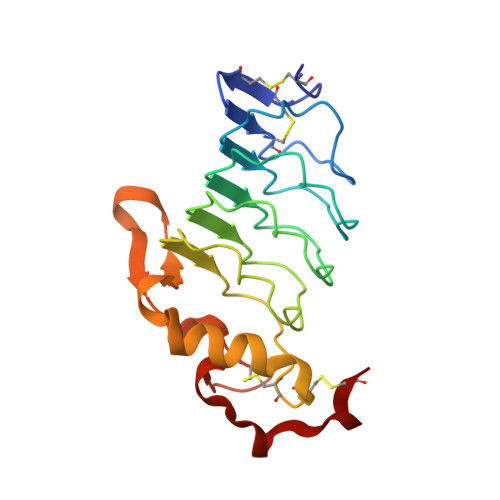Novel lamprey antibody recognizes terminal sulfated galactose epitopes on mammalian glycoproteins.
McKitrick, T.R., Bernard, S.M., Noll, A.J., Collins, B.C., Goth, C.K., McQuillan, A.M., Heimburg-Molinaro, J., Herrin, B.R., Wilson, I.A., Cooper, M.D., Cummings, R.D.(2021) Commun Biol 4: 674-674
- PubMed: 34083726
- DOI: https://doi.org/10.1038/s42003-021-02199-7
- Primary Citation of Related Structures:
7LA7, 7LA8 - PubMed Abstract:
The terminal galactose residues of N- and O-glycans in animal glycoproteins are often sialylated and/or fucosylated, but sulfation, such as 3-O-sulfated galactose (3-O-SGal), represents an additional, but poorly understood modification. To this end, we have developed a novel sea lamprey variable lymphocyte receptor (VLR) termed O6 to explore 3-O-SGal expression. O6 was engineered as a recombinant murine IgG chimera and its specificity and affinity to the 3-O-SGal epitope was defined using a variety of approaches, including glycan and glycoprotein microarray analyses, isothermal calorimetry, ligand-bound crystal structure, FACS, and immunohistochemistry of human tissue macroarrays. 3-O-SGal is expressed on N-glycans of many plasma and tissue glycoproteins, but recognition by O6 is often masked by sialic acid and thus exposed by treatment with neuraminidase. O6 recognizes many human tissues, consistent with expression of the cognate sulfotransferases (GAL3ST-2 and GAL3ST-3). The availability of O6 for exploring 3-O-SGal expression could lead to new biomarkers for disease and aid in understanding the functional roles of terminal modifications of glycans and relationships between terminal sulfation, sialylation and fucosylation.
- Department of Surgery, Beth Israel Deaconess Medical Center, Harvard Medical School, Boston, MA, USA.
Organizational Affiliation:



















